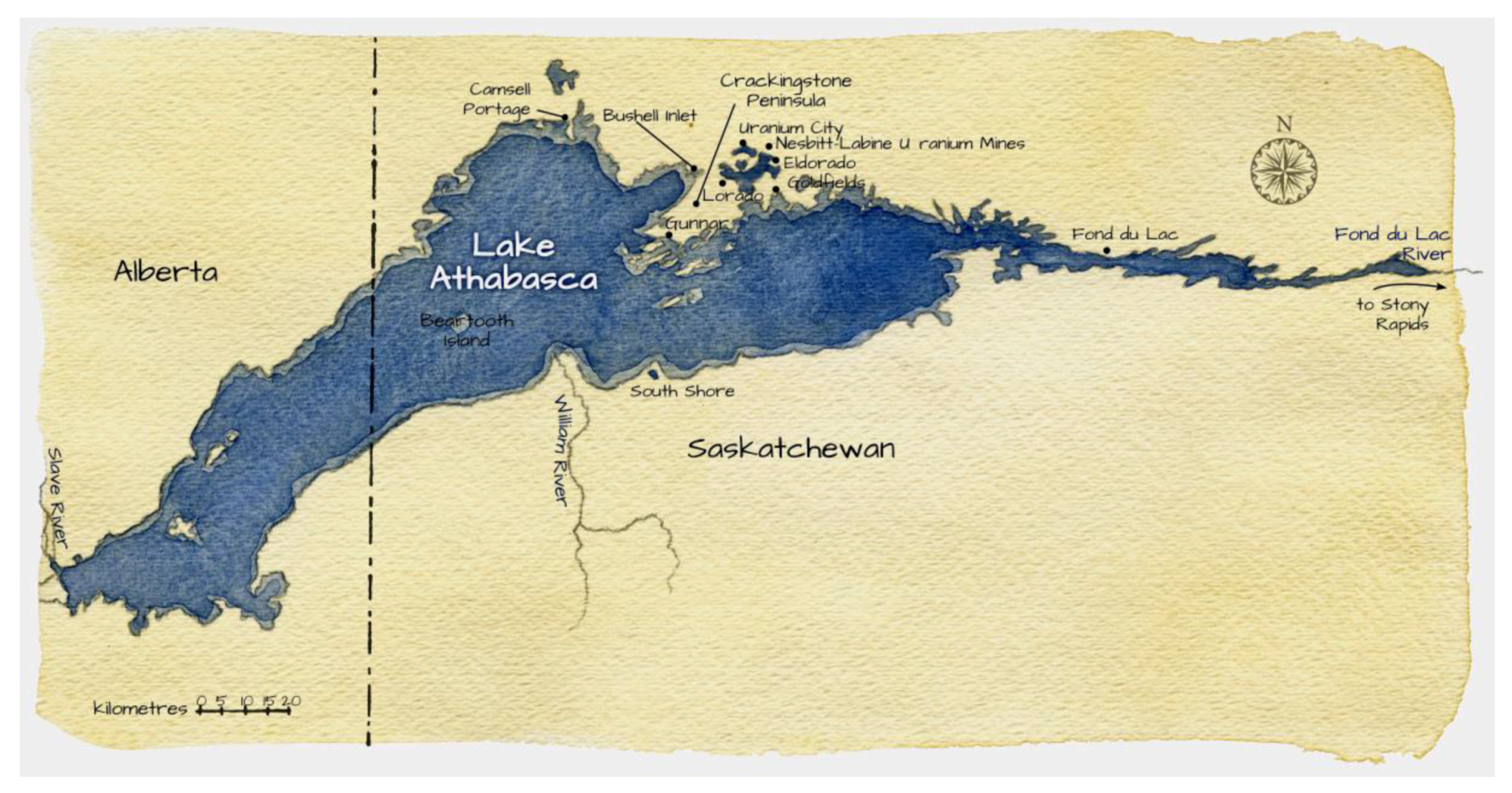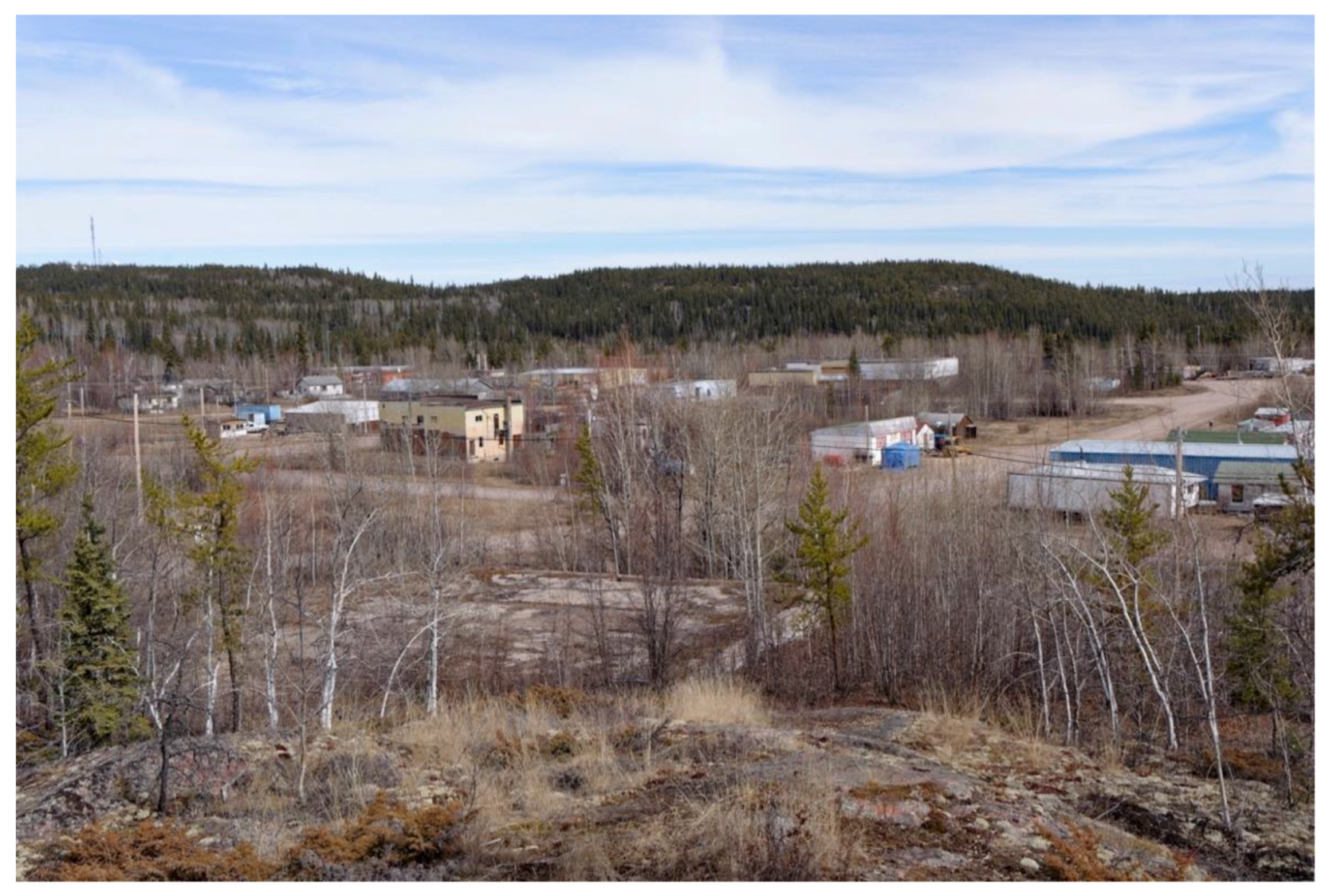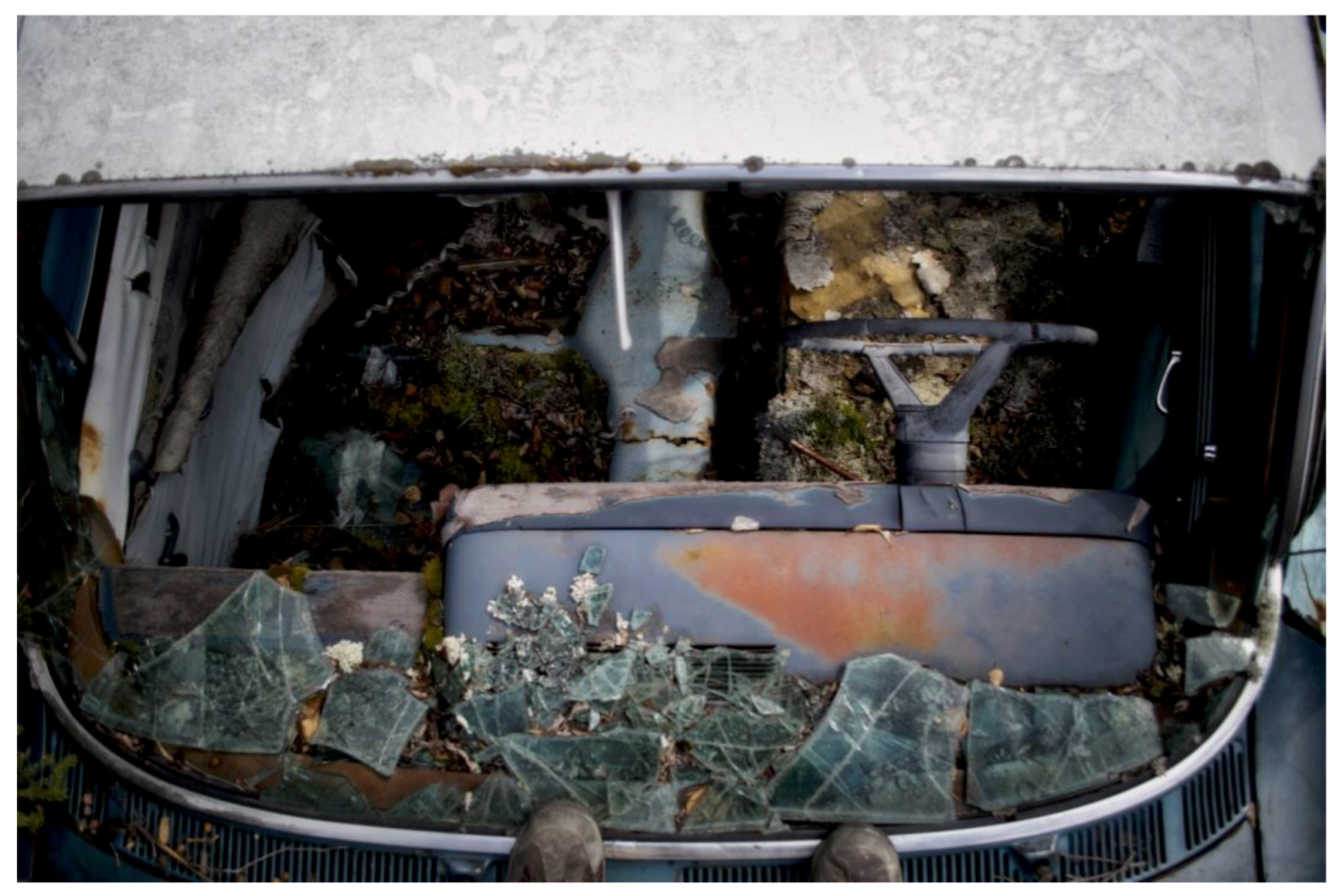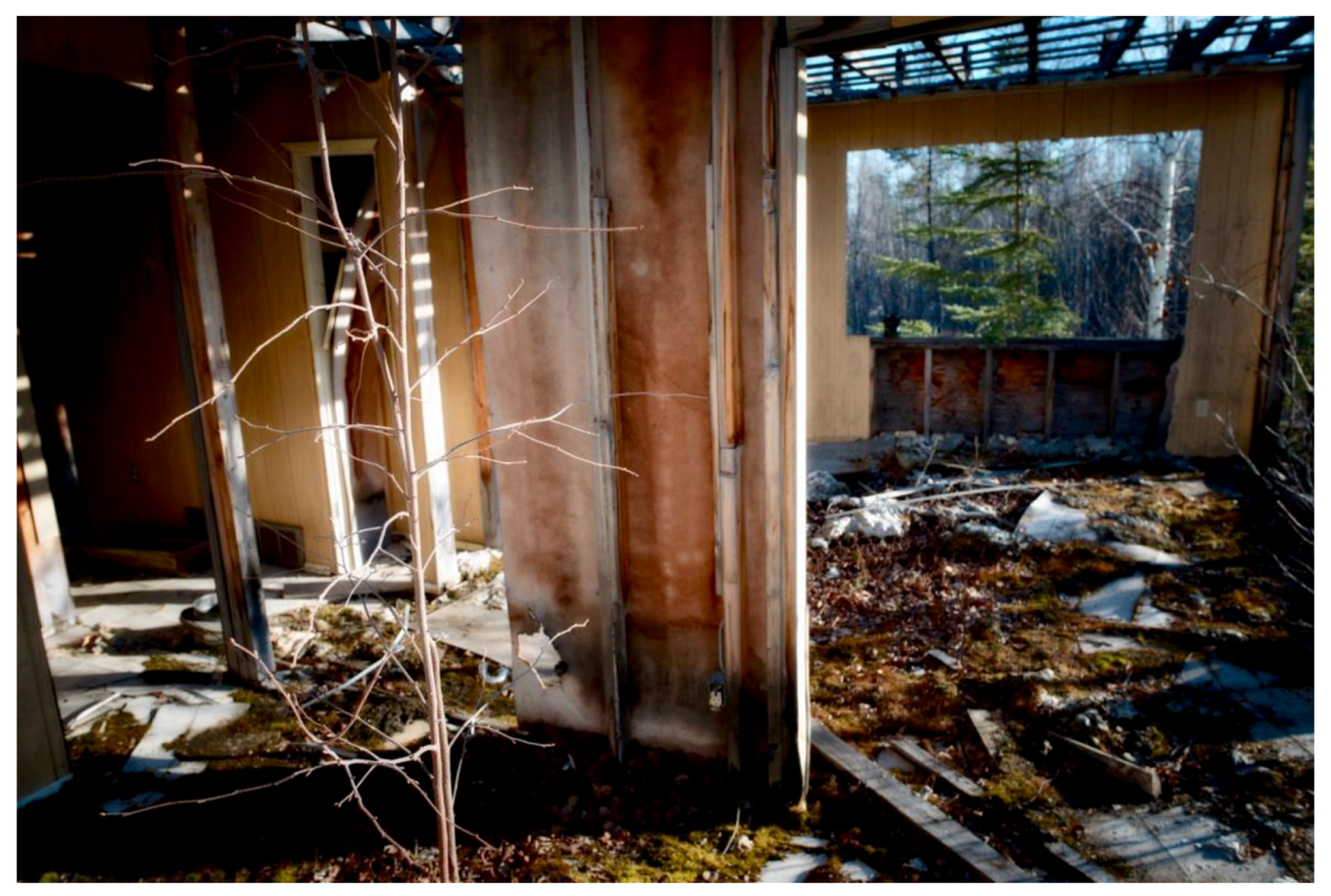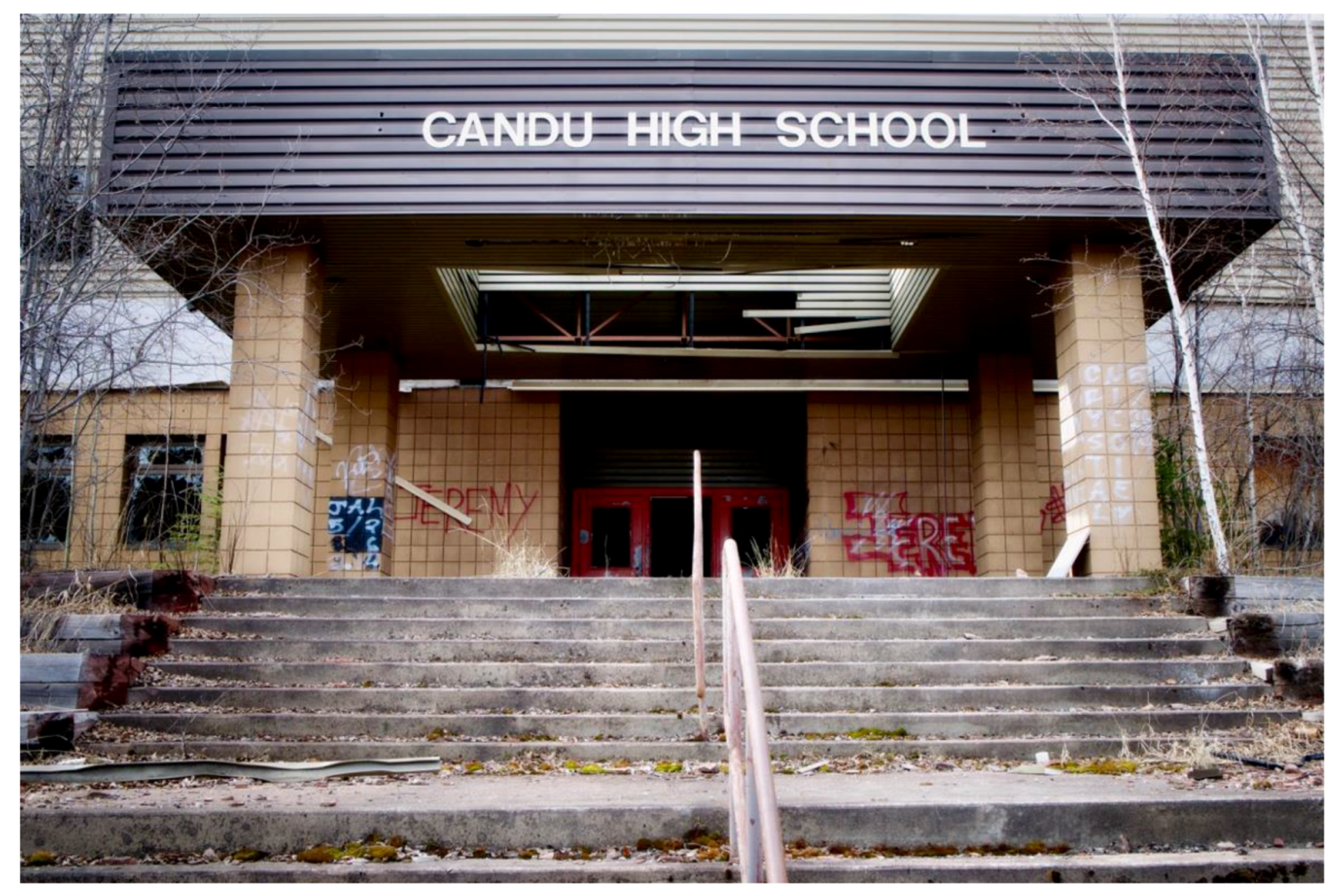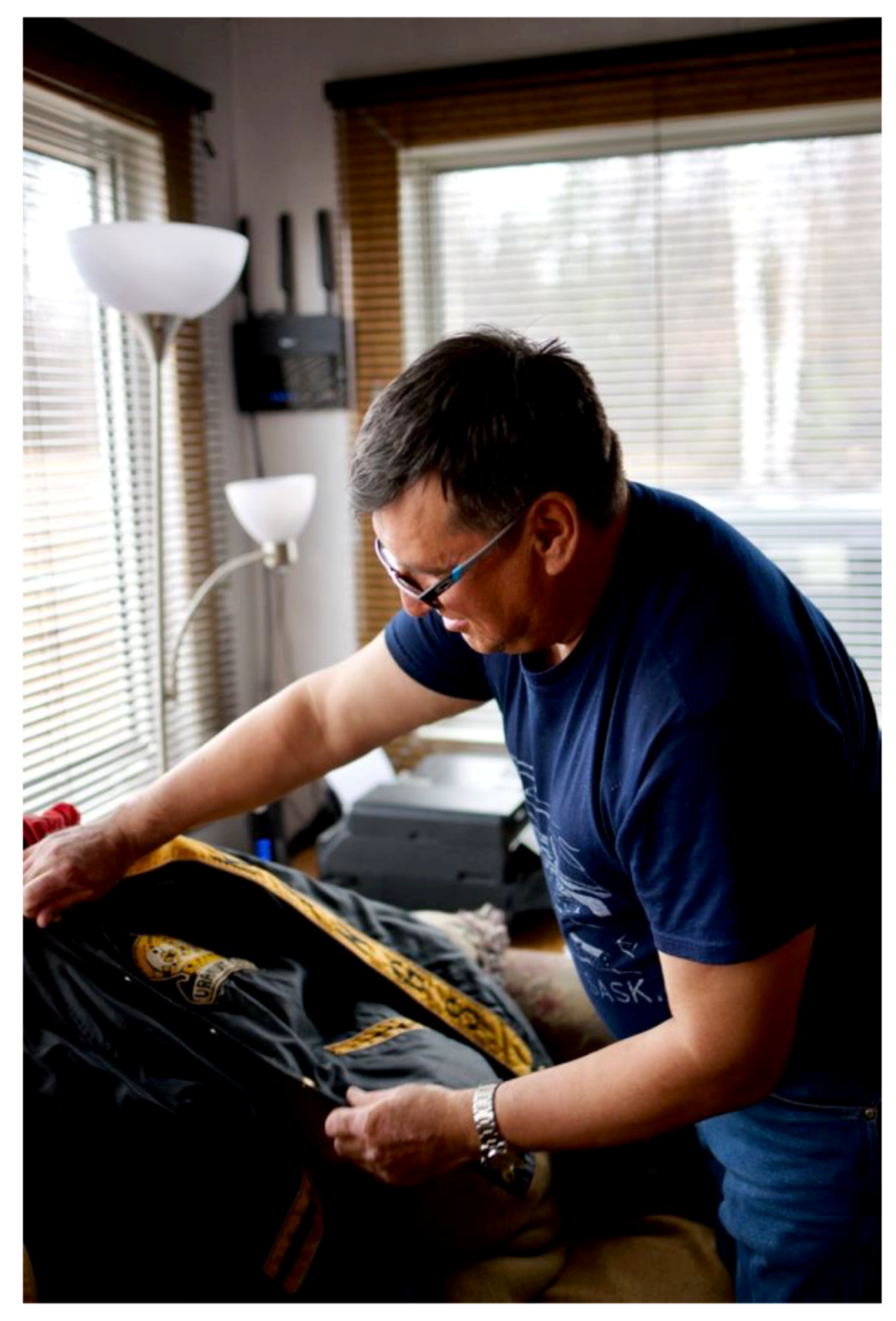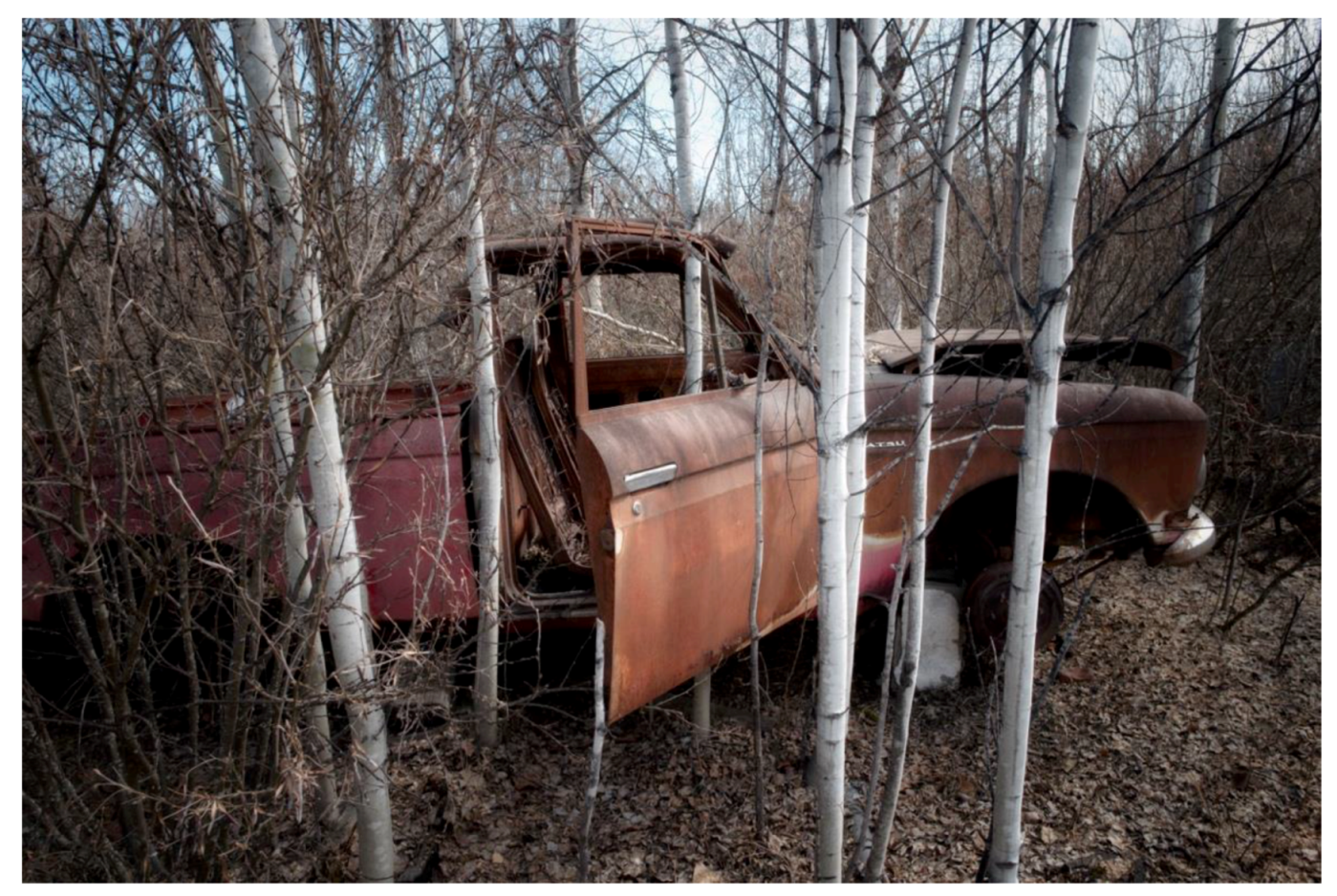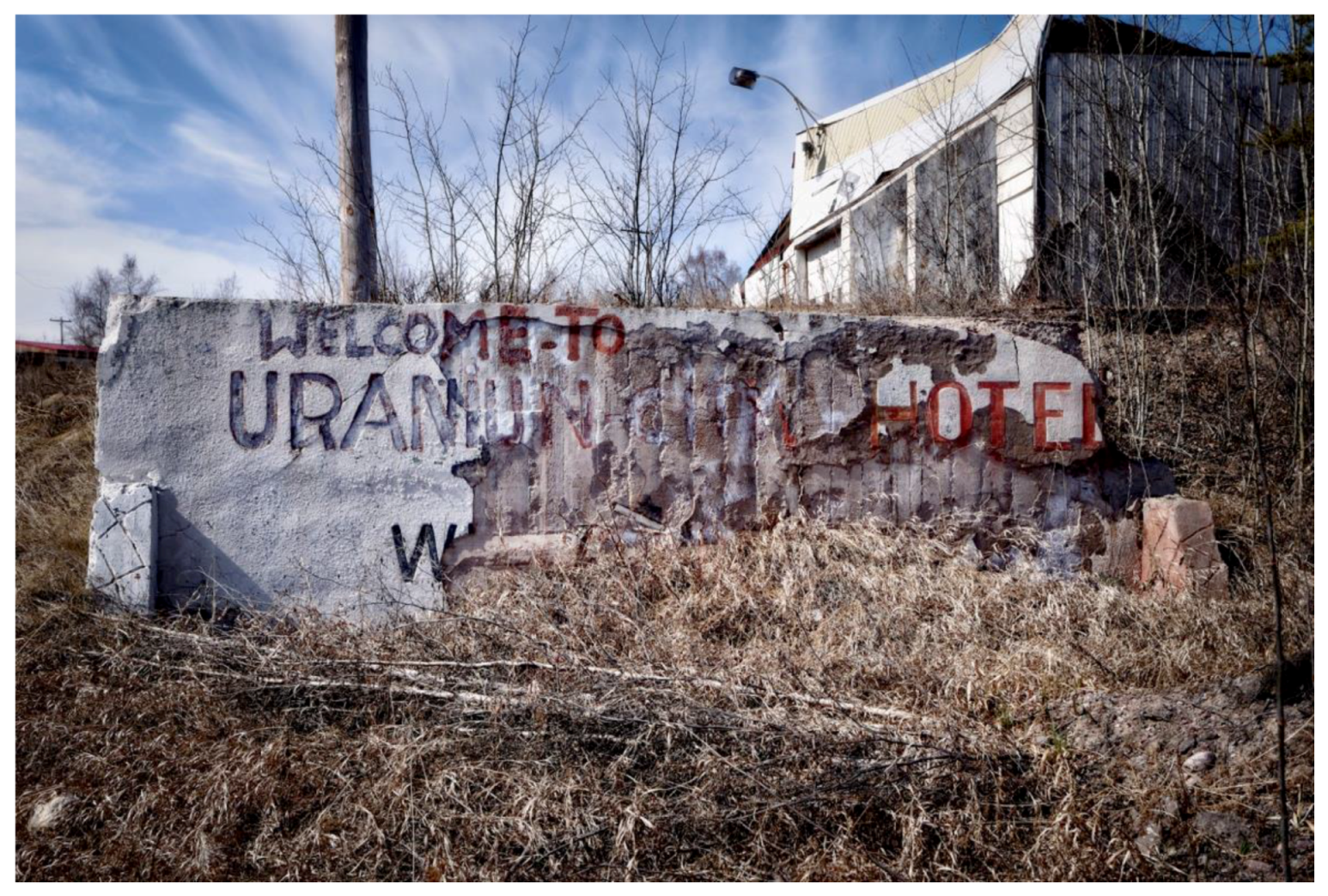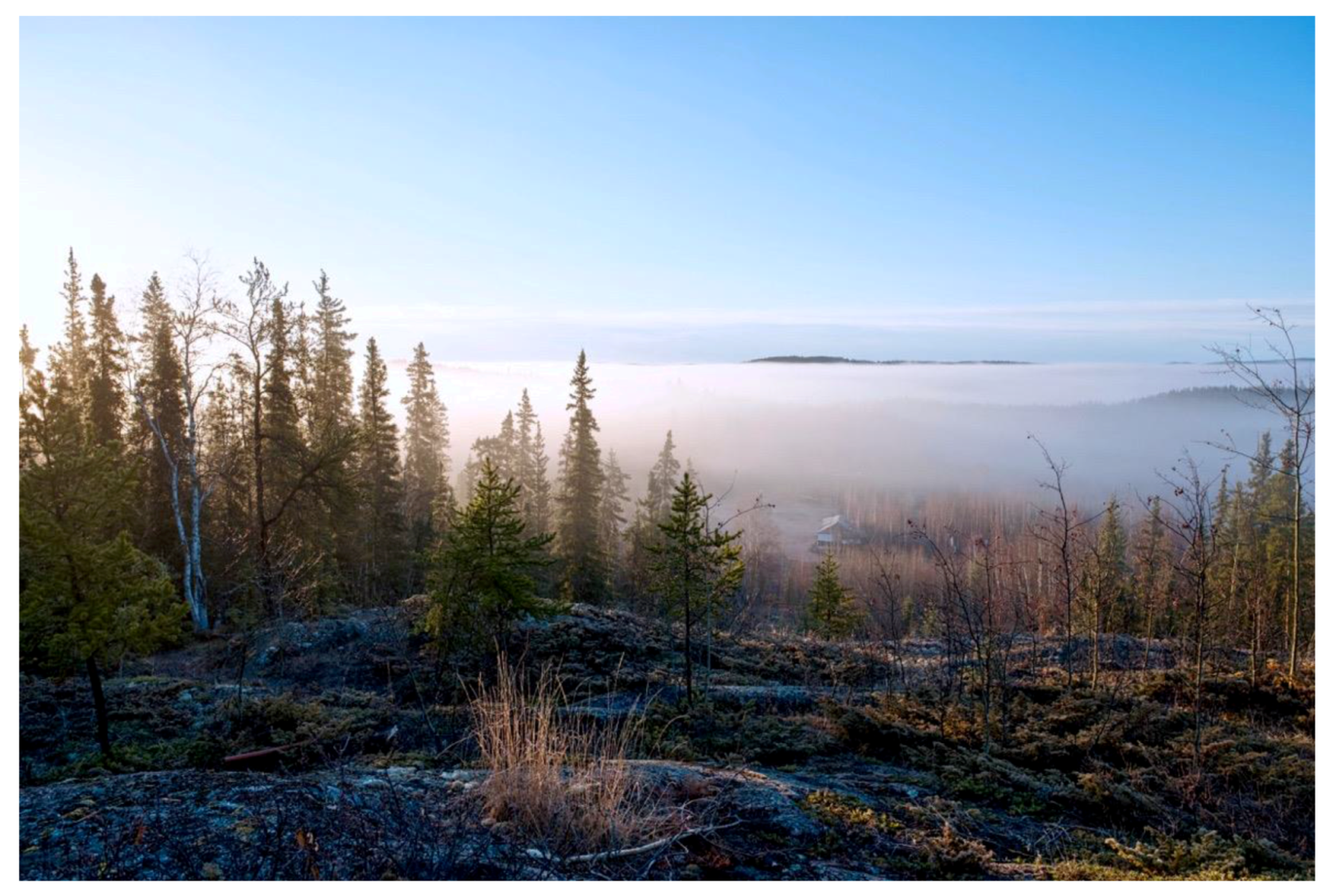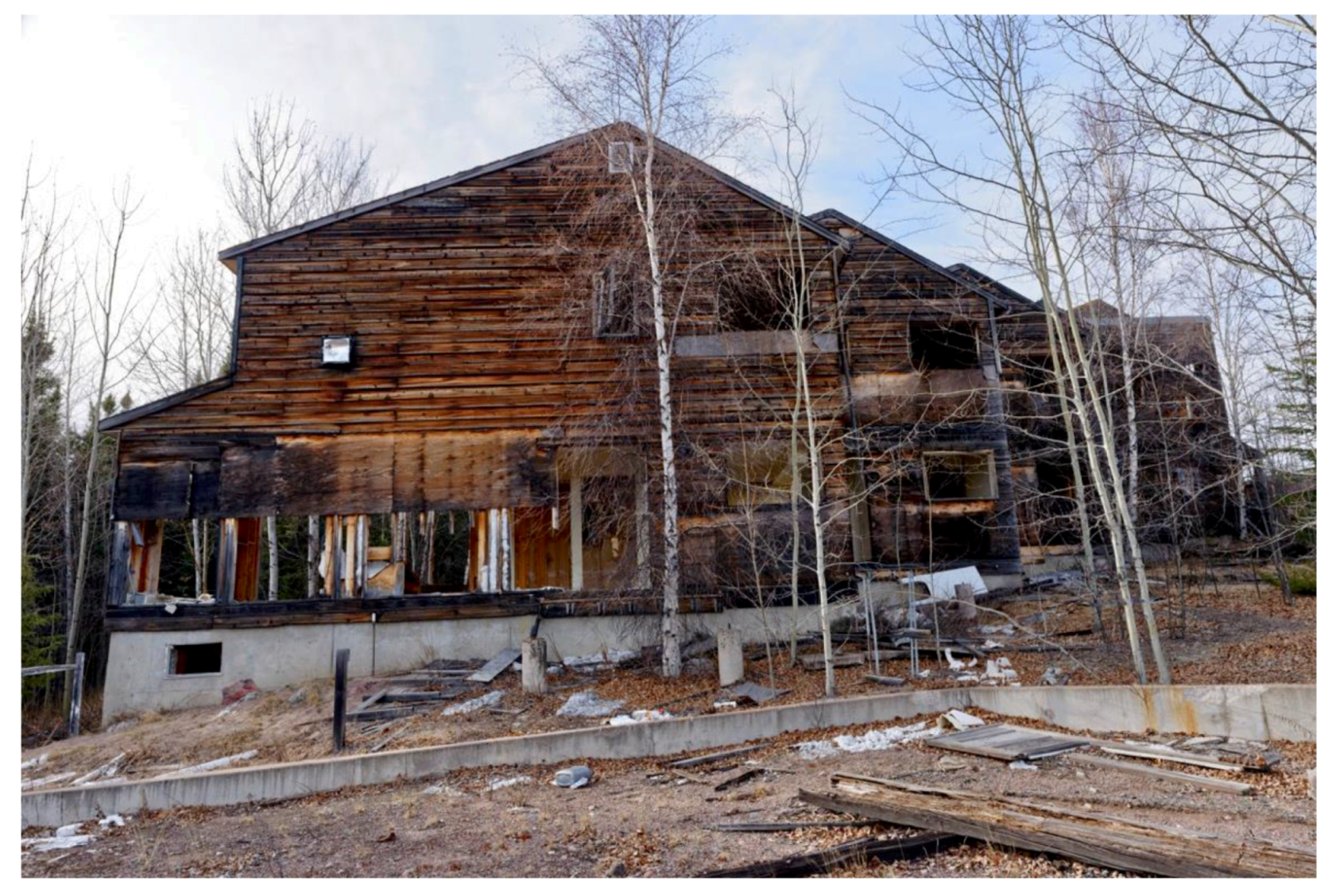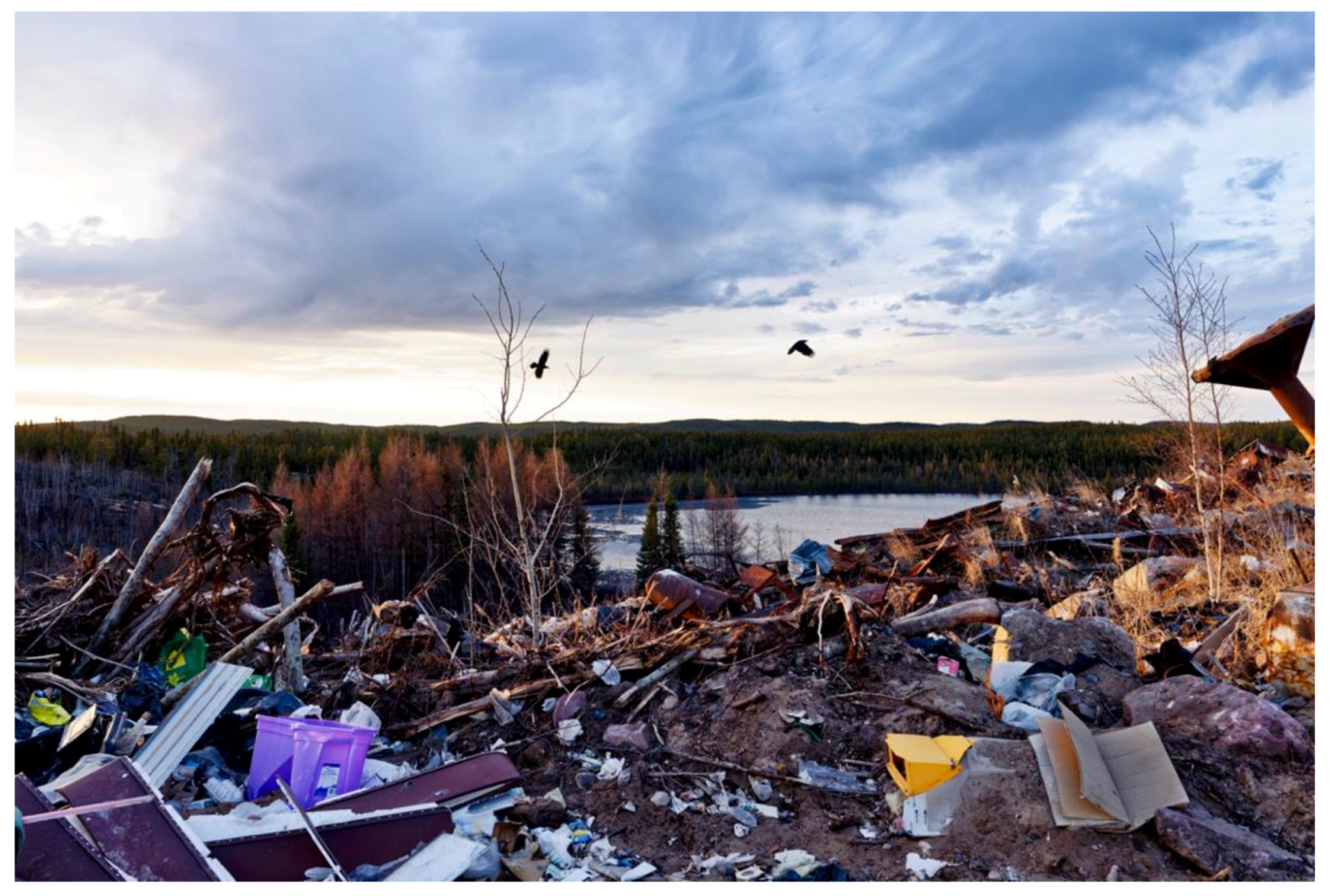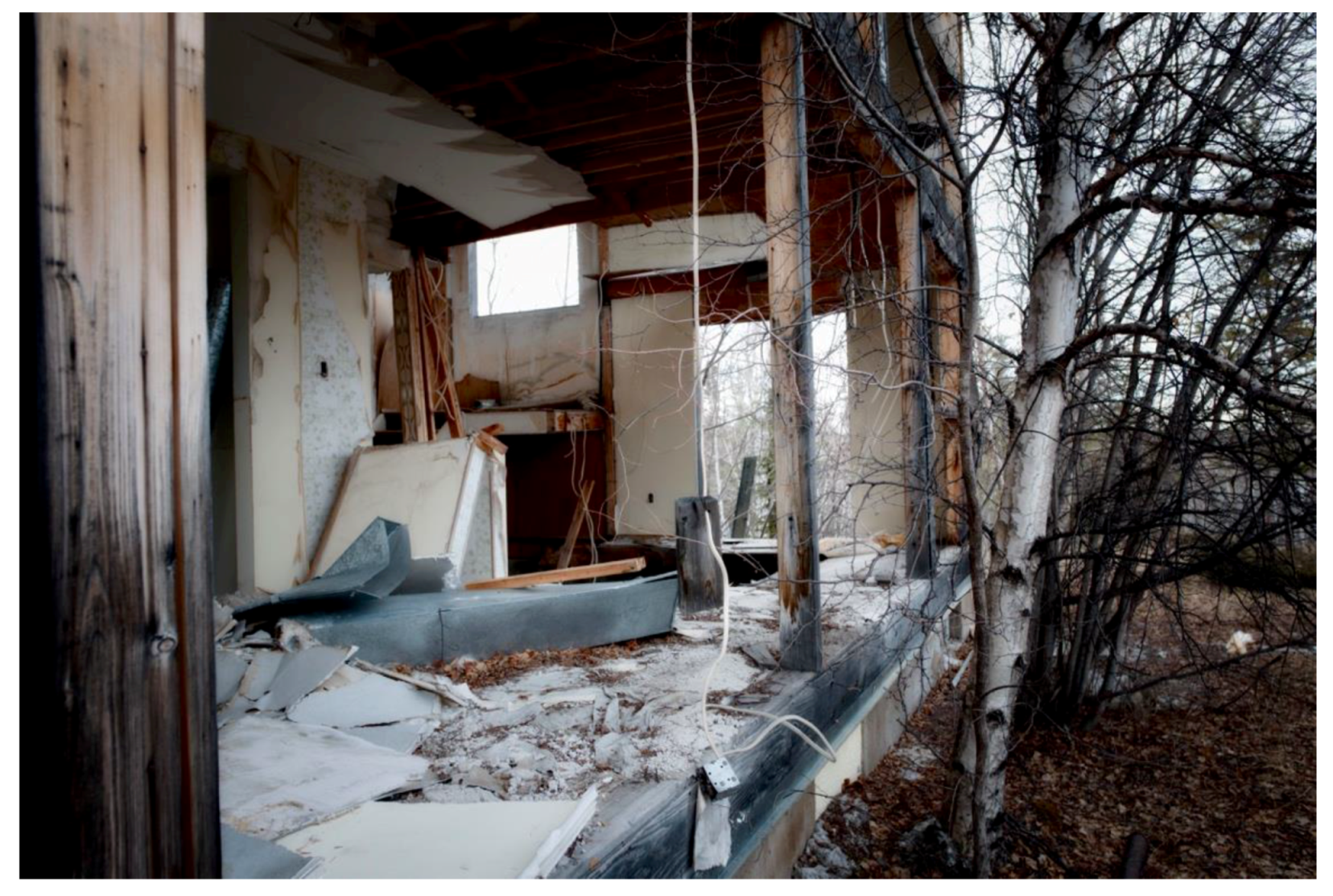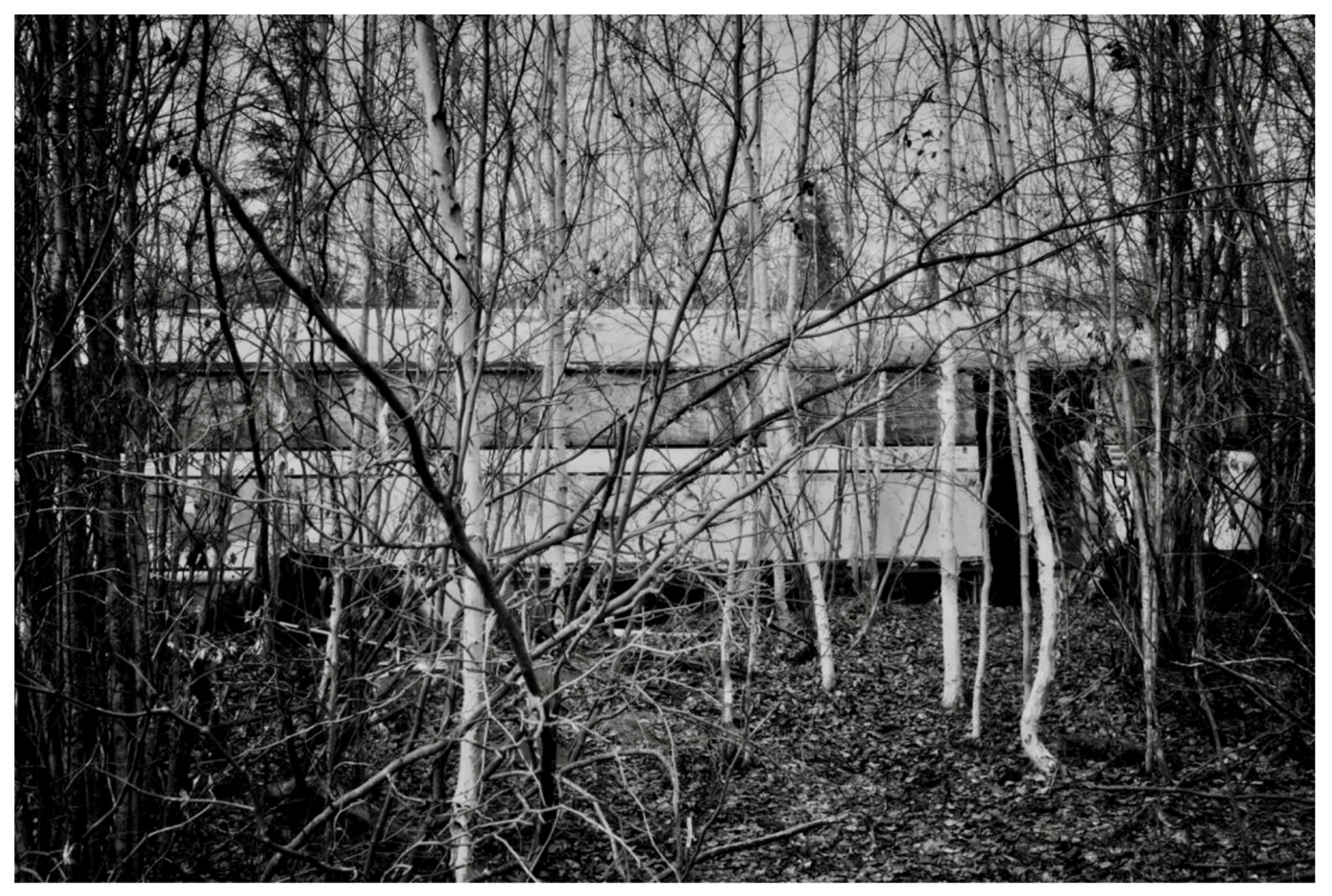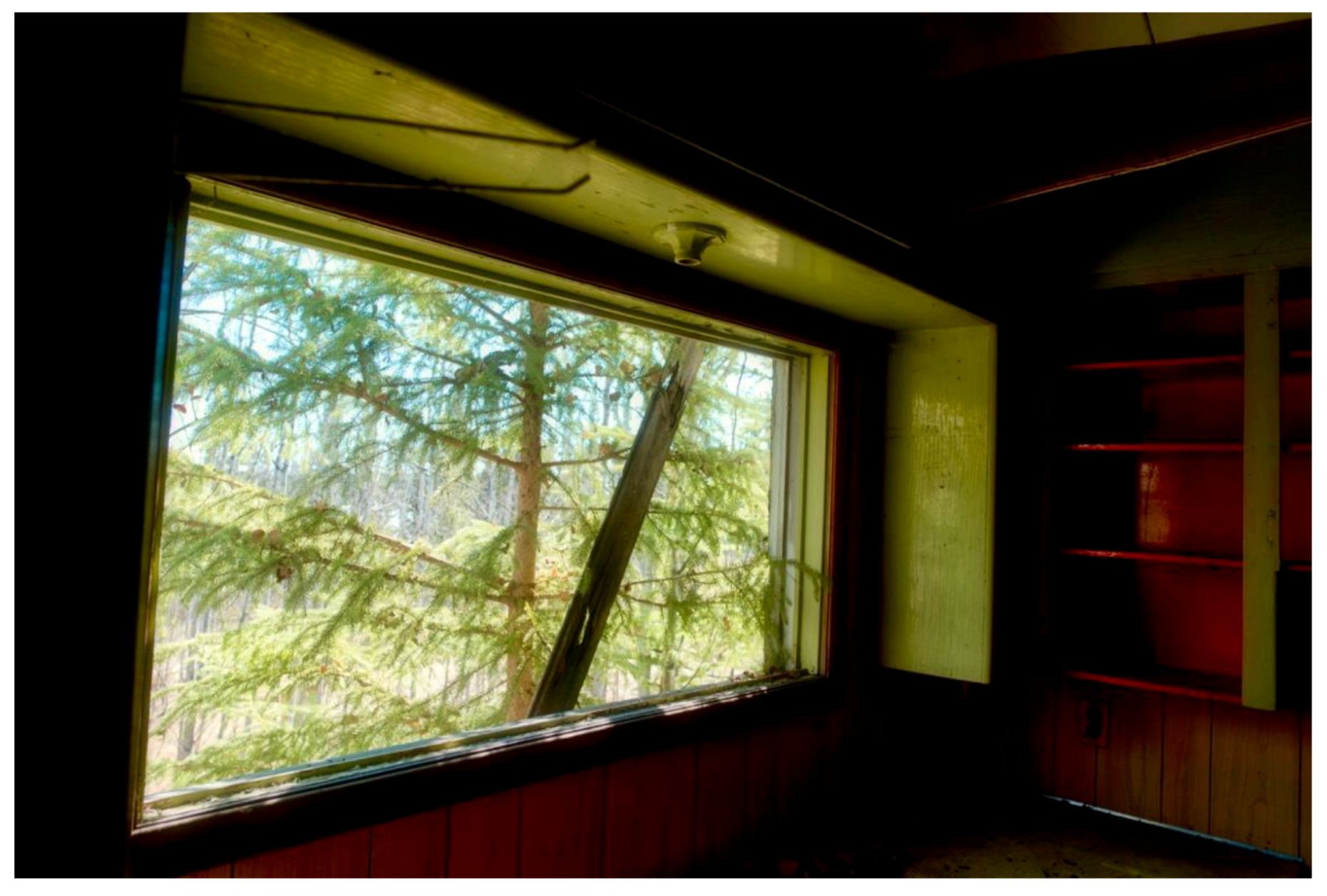1. Introduction
This paper focuses on the Uranium City town site found in the small-lake region of the Precambrian Shield on the north shore of Lake Athabasca, a lake so large it straddles two Canadian provinces (
Figure 1). Although the communities of Fort McMurray and Fort Chipewyan, on the Alberta side of this vast freshwater lake, routinely receive global attention (because of the 2016 forest fire as well as the Alberta Tar Sands containing an estimated third of the world’s oil reserves), Uranium City remains largely unknown to the outside world as well as to many Canadians. Of its estimated thirty-seven regional uranium mines, two
1 in the area have been remediated while a third—the Gunnar mine, mill, and former town site—begins a multi-year cleanup in 2017 at an estimated cost of more than
$100,000,000 CAD (
Muldoon 2017)
2. Uranium City itself, however, remains unremediated, its streets and neighborhoods a haunting testament to the failed post-war ideal of a Westernized community in a remote wilderness based on the extraction of one substance: in this case, uranium ore (which is subsequently milled to produce yellowcake). While the area’s abandoned mines have been prioritized as acute cleanup concerns, the infrastructural and residential core of this region continues to be Uranium City as a town site, vandalized, salvaged, decayed, and reforested. Its current state evokes the environmental lessons and debates of the previous and current centuries. In the words of a resident, Ken Mercredi, a Woodland Cree man who has recently returned to the place of his birth as a guardian and citizen scientist, Uranium City
is the lesson (
Mercredi 2017, Personal Communication).
Near the corner of Nuclear Avenue and Road 962, one can see signs of the early-1980s abandonment of this mining community (
Figure 2). Streets constructed six decades ago are covered by layers of sand and silt; aspen and white birch grow through sidewalks; and street signs marking this unique intersection have long ago been scavenged by collectors. Empty lots, with old foundations exposed and crumbling, contrast with dilapidated buildings still standing from the period before 3 December 1981, when Eldorado Mines Corporation, owned by the Government of Canada, suddenly announced the closure of its mining operations and thus precipitated the town’s rapid emptying. Using a drone in early May 2017, we counted 336 homes, as well as two condo projects, an apartment block, and at least twenty-two commercial buildings, all abandoned. From its peak population of approximately 4000 in the mid-20th century, Uranium City is currently home to about fifty people, a mix of white settlers and people of the Woodland Cree, Dene, and Métis nations. During their everyday lives, these remaining residents experience the legacy of what Harold Innis termed “cyclonic development”. However, Innis, a Canadian political geographer who promoted northern development and played a key role in defining and understanding communities such as Uranium City before his death in 1952, did not address the reality of the abandonment that follows single resource exploitation. Nor did he consider the prospect of remediation—a complex, expensive, and contested process only beginning to be felt by the remaining citizens of this town (
Canadian Press 2017, May 15). In addition, completely outside the scope of Innis’s work are truth and reconciliation, historically set forth by the Truth and Reconciliation Commission of Canada in its 2015 Summary, which offers an important way forward in revising human ecologies as well as the human relationship with other life forms needed to remediate town sites such as Uranium City.
We visited Uranium City in May 2017, coming away with firsthand experience, interviews and communication with residents, photographs, drone footage, and what Bruno Latour calls “matters of concern” (
Latour 2004, pp. 22–23) regarding the terms often used to discuss and historicize mining communities such as this one. One of the things we do as Environmental Humanities scholars situated specifically in an English department at a Canadian university is to dig into words themselves:
cyclonic development and
abandonment appeared to us worth reexamination as we surveyed Uranium City. How are these terms understood and employed in relation to specific environments? Should the narrative arc (so embedded in Canada as it celebrates 150 years) that begins with
discovery and sometimes ends these days with
remediation be reviewed? Perhaps one of the steps towards re-evaluating the narrative of colonial Canada may be to include ourselves as participants, acknowledging and circumscribing the construct of the objective observer writing and documenting in the third person. As descendants of European immigrants to Turtle Island,
3 we are subjects of the very terms—cyclonic development, abandonment, remediation—used to describe the history of the land itself: in this case, a mining town in the far northern boreal forests and Precambrian Shield. We thus include ourselves in our narrative of a journey, the things we saw and documented (
Figure 3), the humans and nonhumans we encountered (
Figure 4), and the porous 1950s-era houses we sometimes stepped inside (
Figure 5).
In the essay that follows here, we delineate three related steps. First, the term “cyclonic development” constitutes a faulty metaphor that naturalizes mining activity in terms of a weather event outside human control and responsibility. Second, the large-scale abandonment that often follows sudden, single-commodity developments such as Uranium City and its environs is relational, and as such abandonment, as a term we unpack, contradicts the cyclone metaphor and its implied natural indifference. Finally, the largely abandoned community that we explored and documented firsthand speaks in its current state to the importance of the land-human relationship, particularly as articulated in the Truth and Reconciliation Commission of Canada’s
Honouring the Truth, Reconciling for the Future: Summary of the Final Report of the Truth and Reconciliation Commission of Canada (
Truth and Reconciliation Commission of Canada 2015). The reforestation of Uranium City over the past thirty-five years especially affected our perceptions and thinking. Even while greater tree growth does not by itself do much to mitigate past decisions with environmental consequences that linger today in the town site itself, which is our specific concern, the trees themselves offer a valuable lesson regarding the relations between humans and nonhumans. The lesson, we contend, can be brought forward into currently inhabited communities where choices become policies. As we demonstrate throughout this paper, the impacts of large-scale mining events such as occurred in the twentieth century in Uranium City resulted from human decision-making. As Elizabeth A. Povinelli observes regarding former mining communities in Australia, “[T]hose persons who were left to inhabit the toxic fields made by others are given the job of removing them” (
Povinelli 2016, p. 88). Even within the contexts of colonial and capitalist activities, which can seem like large-scale, uncontrolled, and impersonal forces, the cyclone metaphor works against recognizing and acknowledging human agency and responsibility, which are in turn crucial to truth and reconciliation.
3. Uranium City’s Abandonment and Residual Maintenance
Mayor Dean Classen, who has lived in Uranium City all his life, says of its abandonment that “it doesn’t bother me anymore, but it used to” (
Classen 2017, Personal Communication). It has taken him decades to process the mass exodus he witnessed in his youth, while continuing to live there and manage the remaining community’s vital functions. In addition to pursuing his administrative duties as mayor, Classen looks after bulk fuel, banking, satellite communications, transportation, infrastructure maintenance, and airport security, among other things. Mayor Classen does all this, in effect, as a lifelong response to decisions made by others in the past. He was preparing to graduate from the then new Candu High School (
Figure 6) when the president of Eldorado Mines Corporation, Mr. N. Edigar, suddenly announced the closure of operations on 3 December 1981 (
McIntyre 1993, p. 315). The largest mine, Beaverlodge, had been running continually for thirty years. The people who directed Eldorado had recently purchased a new Boeing 737 airliner, built new housing and other facilities, and improved the mine, spending over
$100 million CAD in the year before the closure announcement (ibid., p. 315). Given such expenditures as well as the Crown Corporation’s other indicators that business would continue into the future, the community of approximately 4000 then living in Uranium City could not have seen what was coming. Eldorado’s commitment to infrastructure in the form of such substantial capital outlays belied its own announcement and was therefore met with disbelief. The then brand new Candu High School itself was a testament to the announcement’s incredibility. Yet the 1982–83 academic year would be the last for this state-of-the-art education facility. Candu High School, named after Canada’s unique heavy-water nuclear reactor sold to countries such as India (
Sandberg 2016, p. 28;
Candu Owners Group, Inc. 2016), would soon serve as one of the central figures in Uranium City’s subsequent history (
Figure 7).
Ty Lloyd is a water resources engineer who regularly visits Uranium City for periods of several weeks in order to monitor flow rates in the region. We roomed with Ty in the town’s only BB, operated by Mayor Classen and his wife, Giselle, who maintain several houses in order to accommodate the steady stream of visitors: scientists, researchers, fishers, hunters, and the occasional journalist or photographer drawn to the town’s remains. Lloyd is contracted by regional lease managers to oversee the ongoing water quality and quantity monitoring in the Uranium City area (
Lloyd 2017). Every evening during our stay, he engaged us in conversations about abandonment and place, especially this place. Lloyd maintains that the community is not abandoned (
Lloyd 2017). The Dene and Woodland Cree, with their distinct languages and traditions, have relationships to the area that pre-date uranium “discovery” and mining by centuries (
Deranger 2017, Personal Communication). They continue to live here and many return every summer to hunt and fish. The Dene associate Beaverlodge Mountain with a creation myth (
Deranger 2017). Ken Mercredi, part of a distinguished Cree family, maintains a summer home in Uranium City and works closely with both Dean Classen and Ty Lloyd. If Ken isn’t assisting the Mayor at the bulk fuel office or the airport, he can be found guiding Lloyd into a particular watershed. Allen Augier is a Métis man who is a permanent resident and works in environmental remediation for the Saskatchewan Research Council (SRC) (
Augier 2017). His small 1950s bungalow, sitting on a street with derelict homes and empty lots, is meticulously well kept, his living room filled with sports memorabilia and trophies dating to his youth when he played defense for the Uranium City Kings hockey team (
Figure 8). The Classen BB also accommodates young professionals who routinely visit Uranium City. Shelley Fisher, for instance, is an ornithologist who spends every waking hour counting bird species within precise volume units of land; every evening she asked us to recount the birds we had seen, heard, or in this case—that of a Great Horned Owl—photographed (
Figure 4). In addition, Colin Popoff, on behalf of the Saskatchewan Power Corporation, flies in once a month to check the local grid. These figures and others can be seen on any given day driving trucks and quads provided by the Classens as they go about their business on behalf of the community. Indeed, posted to the wall by the landline phone in the BB dining room is the Uranium City directory, which includes local numbers for neighbors, businesses, services, the Ben McIntyre School, and the Health Center (though there is no doctor): all evidence that Ty Lloyd is right—Uranium City is not abandoned.
Our exploration of Uranium City took five full days (3–8 May 2017) and what we experienced during those days seemed to contradict, powerfully at times, Ty Lloyd’s position, fueling our evening discussions about abandonment. Each day we employed an array of digital and film cameras as well as a drone, documenting each street from the ground and air (
Figure 9). We photographed suburban neighborhoods that hadn’t been lived in for thirty-five years, while a few others closer to the center contained intact homes with human occupants. We saw reforested yards, picket and wire fences, sidewalks, playgrounds, and parks—in short, the spaces commonly found in cities occupied by humans. We documented infrastructure as well: basements, manholes, foundations, water lines, fire hydrants protruding still in seemingly absurd places, and a nearby adit, a private horizontal mine shaft installed long ago by a prospector. We visited institutional sites of gathering, dispersal, burial, and disposal: the sealed Roman Catholic church, the well-kept cemetery, the Canadian Legion Hall, the Uranium City landfill, and the vandalized Candu High School. Someone directed us to an automobile junk yard containing not just dozens of vehicles but also a small fleet of city buses, all locked into the space and time of this region—accessible on the ground only in winter on the ice-road traversing Lake Athabasca west to Fond du Lac—and all now well-forested. When we noticed a mature tree growing between an abandoned Datsun truck cab and its open passenger door, we knew a long time had passed (
Figure 10). As we documented such instances repeatedly, we also noticed our own fatigue and creeping desensitization. We took frequent rests, during which we discussed the concept of abandonment as well as our immediate responses to the many scenes we were encountering.
Abandonment is relational. As a term with Old French etymologies in legal, moral, religious, and mercantile contexts, abandonment in its historic forms and usages, refers to the constraints, bonds, and boundaries of relationships (OED). In medieval Anglo-Norman, it is related to renunciation and therefore the acknowledged trust within and by a community that some individuals may choose to forego what others agree not to forego, e.g., commonly enjoyed pleasures, possessions, inhibitions, and/or relations, and implies freedom and agency, all of which contradicts the cyclonic development metaphor. Abandonment is the negative of bandonment or boundonment, a state of being bound or in a bond or set of bonds to humans and nonhumans. Its origins in the Old French bandon also point to its public meaning communicated through “proclamation, ban, jurisdiction, authority, disposal, discretion, license”, terms that, like abandonment, are ultimately derived from Latin (OED). Abandonment can be active or passive: one can abandon or one can be abandoned. Abandonment, specifically in environmental terms, is agentic and, as such, reaches into everyday decisions regarding relationship. It happens across scales of space and time, from the individual act of discarding a plastic bag to a community’s decision to allow methane to leak from its landfill and a corporation’s refusal to account for its carbon emissions.
Abandonment is temporal—acknowledged or not, it assumes a position relative to history and memory that things, places, and people can be left behind. Sometimes abandonment is quite necessary. However, it must be acknowledged that abandonment is primarily a dereliction of relationship. In Uranium City, then, individuals such as Ty Lloyd, Allen Augier, and Shelley Fisher are contracted to attend to what has been left behind, recognizing that decisions rendered by others many years ago still impact the water, soil, air, and life forms in this space. In their commitment to a place, and acting on behalf of organizations such as SRC, they see Uranium City as having not been abandoned, although there is so much (perhaps at times too much) work to do.
Abandonment also entails going outside decision-making limits determined by consensus in a community or group and may constitute a breach of trust, one which can occur at any point in the conventional Western linear narrative (
Boschman 2009, pp. 1–3). As we continue to interview people with ties to Uranium City, we often witness grief. Some of our contacts were born on Hospital Hill during the 1950s and 1960s because their parents had moved to Uranium City from places as far away as Ireland and Germany in order to work (
McCaffery 2017;
Melzer 2017), only to be forced to leave the place where they had grown up when others decided that mining was no longer viable. First Nations persons, such as Patrick Deranger, have a different story of loss. Patrick ran free in the woods as a very young Dene child before his family—in place on this land since time immemorial—was forcibly relocated and he was made to attend a residential school (
Deranger 2017, Personal Communication). Abandonment, in the case of Patrick Deranger, occurred during the “boom” phase of Uranium City’s development. Although Deranger has not been back to Uranium City in over fifty years, his connection to this place is powerful. He asked us, before our departure, to locate the house in the forest where he had lived with his family. Prior to his family being relocated to this site, his grandparents had lived on the town site itself well before Uranium City was conceived, planned, and established just after World War Two (
Deranger 2017). They occupied the land where the Uranium City Hotel would later be built (
Figure 11) and were subsequently forced onto a nearby hillside along with other First Nations before being relocated again to Fort Chipewyan on the Alberta side of Lake Athabasca, where they found themselves living in a tent on the beach. As Deranger testifies, they became refugees, displaced from their own traditional home: “The Mikisew Cree saw us and took pity on us and brought us into their community”. To help us find his familial home, Patrick drew us a map, which turned out to be very precise as we foraged through mixed forest and rock. We photographed the site, left tobacco following First Nations protocols, and retrieved a piece of white birch bark, a pink rock, and a doorknob lying in the mossed-over remains of the door to the Deranger home to give to Patrick on our return.
Patrick Deranger’s story regarding the dislocations and betrayals he and his family experienced arising from the establishment of Uranium City in the early 1950s points to the reality of abandonment in its own temporal frames. There is not a single abandonment but many abandonments that occur when economy and cultures, each comprised of human agents, interact. Non-Indigenous peoples, often in family units, came from around the world to work in Uranium City (
McIntyre 1993, pp. 58–64, 65;
Sandberg 2016, pp. 51–76). Eldorado Corporation, on behalf of the Government of Canada, moved families from Ireland and Germany, especially during the initial years of the Beaverlodge operation (
McCaffery 2017;
Melzer 2017). The children of these and other immigrants grew up in Uranium City; their parents bought homes and took out mortgages, built cottages, and grew to love and become immersed in the region’s unique landscape (
Figure 12), with its red and pink rock dominating the hills of the northern shore of Lake Athabasca. From the air, one can see extensive deserts of white sand along the southern shore, where ancient Indigenous hunting implements have been discovered (
Mackie 2017, Personal Communication). According to Patricia Sandberg, “More than fifty companies were reported to be working in the Beaverlodge area in 1954, and Uranium City was the hub” (ibid., p. 28). Nearly thirty years later, when Eldorado, the largest and most powerful company, decided to call it quits, thousands of people were forced to leave despite desperate efforts by community leaders to create new plans for Uranium City’s economic survival (
McIntyre 1993, pp. 314–23). Many walked away from properties they owned and cherished and on which they held mortgages (
Mercredi 2017). “People were really hurt, especially homeowners” (
Classen 2017). No compensation was offered (
Mercredi 2017;
Classen 2017;
Melzer 2017). A large condominium and apartment block complex was completed in the early 1980s and never occupied, standing to this day as a testament to the complexities of abandonment that cyclonic development as a metaphor cannot adequately represent (
Figure 13). The construction company contracted to this project fulfilled its obligations in order to be paid, knowing, along with everyone else, that it would never be lived in (
Mercredi 2017). Today former and current residents of Uranium City still feel misled by the infrastructure and investment that preceded and even extended beyond the closure announcement by Eldorado Mines on 3 December 1981 (
Classen 2017).
Although the region around Uranium City constitutes an area of acute environmental concern and is undergoing expensive and necessary remediation that involves government, corporate, and community actors, Uranium City itself receives no cleanup funding (
Classen 2017). The Beaverlodge mill and mine sites established and operated by Eldorado for thirty years were bulldozed and buried in the years immediately following the closure that became effective as of June 1982 (
Sandberg 2016, p. 217). The mine shafts, supposedly a mile deep, were sealed during this process (
Figure 14). The Lorado mill and mine sites, on the other side of Uranium City, were only recently remediated by the Saskatchewan Research Council on behalf of the Government of Saskatchewan (
Sandberg 2016, p. 217). Farther away, Gunnar Mine and Mill, the older open pit mine and mill, is beginning its cleanup, with an estimated cost of more than
$100,000,000 CAD to be borne by the governments of Saskatchewan and Canada (
Muldoon 2017;
Sandberg 2016, p. 219). Estimates of other, smaller sites requiring remediation range between thirty-seven and forty. The Saskatchewan Research Council (SRC) was formed in 1947 by the provincial government of Saskatchewan in order to identify sites of concern and implement remediation (
Muldoon 2017;
Saskatchewan Research Council 2017). However, no funding has been directed towards the remediation of the Uranium City site itself (
Classen 2017). A faded sign that warns people to stay on the roads (
Figure 15) testifies to the hazards we identified: open pits and foundations; holes, troughs, and wells; rusted metal and ironworks; nail- and screw-bearing wood, cement, and metal; broken glass; discarded fuel and chemical containers; numerous abandoned vehicles at multiple locations; and former houses and other structures in various stages of collapse. Some of the latter we could not or would not enter,
4 though we did carefully survey the Candu High School. Homes, larger structures, and vehicles throughout the town site bear evidence of extensive vandalism, a concomitant of abandonment. The remaining residents have voiced their concerns about the possible effects of breathing the dust-laden air, a concern we support out of our experiences on the dusty roads and lots throughout the area (
CBC News 2010).
The town landfill, finally, continues to be used even though it dates from the mid-twentieth century and is therefore built on technologies from a previous era (
Figure 16). We agree with Ken Mercredi’s opinion that the landfill contents should never be moved, and laud his efforts to identify water outlets in the immediate vicinity of the landfill site bordering on Frank Lake (
Mercredi 2017, Personal Communication). We also accept his opinion that runoff is contained to Frank Lake. At the same time, the two dominant narratives of garbage, as Lindner and Meissner write in their introduction to
Global Garbage: Urban Imaginaries of Waste, Excess, and Abandonment (
Lindner and Meissner 2016), are also on our minds: “the narrative of garbage as relational (as an entity relative to something within a socio-symbolic system) and the narrative of garbage as revenant (as refuse that refuses to be disposed of)” (ibid., p. 395). Both narratives apply to Uranium City and both support our argument that cyclonic development as a term requires reexamination. Moreover, we do not think it equitable that community citizens, however knowledgeable, should bear the burden by themselves of monitoring the consequences of decisions taken by others decades ago. Without residents such as Ken Mercredi, Allen Augier, the Classens, and others, all of whom are in their fifties and sixties, who will undertake voluntarily to monitor the Uranium City landfill as well as other sites of concern in Uranium City itself?
4. Relationship and Land
In Uranium City, we saw poplar and other deciduous trees such as birch growing profusely through the once idealized post-war neighborhoods built to pursue nature’s unstable heaviest element, U-235. We entered a nearby adit, a horizontal mine shaft, one rainy afternoon. Such places can still be found in the Uranium City region, stemming from the mid-twentieth-century period when the quest for U-235 was at its most euphoric and few of its dangers were as yet practically recognized (
Zoellner 2009, pp. 38–129;
Sandberg 2016, pp. 9–21). Although we could walk into the adit no more than about thirty feet, as its floor was covered in thick, treacherous ice, we used a zoom lens to extend our subterranean sight as far as we could (
Figure 17). We wanted to see into this small-scale example of tunneling for an ore that changed the English language with concepts based on breaking the sub-atomic relations that hold U-235 together: releasing—or we could say
abandoning—its power all at once. This bursting of the “overloaded” U-235 atom is in fact a kind of frenzied, prolonged series of divorces: “Losing its center piece by piece,” writes Tom Zoellner, “uranium changes shape as it loses its protons—it becomes radium and then radon and then polonium—a lycanthropic cascade that involves thirteen heavy metals before the stuff finally comes to permanent rest as lead” (
Zoellner 2009, p. 92). For places such as Chernobyl, Fukushima, and Uranium City, the oft-used metaphors incline towards containment, hermeticism, remediation, and abandonment, all of which imply choice, decision-making, and agency. There is talk among Uranium City alumni about what went down the Beaverlodge mine shaft before it was sealed in September 1982—transformers, heavy equipment, and truckloads of sulfuric acid (
Lloyd 2017). These narratives evoke the complex power paradox of the Uranium City region: entombment and letting go; imprisonment and release; cordoning off, abandonment, and growing in. When we walked down streets with houses, sidewalks, power poles, and fire hydrants that hadn’t been used in over thirty years, we could see firsthand the lesson of Uranium City referred to by Ken Mercredi. The lesson for us is relational.
We observed that the trees that have now grown into the abandoned neighborhoods of Uranium City—through the infrastructure and sometimes right through the houses themselves—have something to say (
Figure 18). Consultation with all manner of trees in Uranium City could have wide-ranging effects connected to life, hope, and creative planning for present and future human communities. Porousness could be increasingly recognized and embraced within current architecture and planning practices; not that humans in the twenty-first century would permit porousness but rather acknowledge more fully the reality of the porous relationship with the rest of nature (
Figure 19). Rather than merely well-treed cities, we could move toward forest cities where vulnerability and relation are made more explicit. Rather than the stock ambivalence toward poplars based on fear of their root systems, as is the case in our home city of Calgary (
City of Calgary 2017), perhaps building practices could adapt to new models along the lines of Tim Ingold’s description of what a human already is: “the whole-organism-in-its-environment” (
Ingold 2000, p. 759). Cairns and Jacobs’ concept of “architectural agency” would also be involved, in what they call “a less defensive relationship between architectural creative action and death” (
Cairns and Jacobs 2014, pp. 231–32). Another tree expert, David George Haskell, comments: “Because life is network, there is no ‘nature’ or ‘environment’, separate and apart from humans. We are part of the community of life, composed of relationships with ‘others’, so the human/nature duality that lives near the heart of many philosophies is, from a biological perspective, illusory” (
Haskell 2017). Finally, and most important, Indigenous peoples with their traditional environmental knowledge (TEK) require genuine, actionable acknowledgement.
In Canada, the
Truth and Reconciliation Report Summary (2015) repeatedly cites environmental knowledge and practice as a component of reconciliation and healing. As one elder, Reg Crowshoe, states:
When we talk about the concept of reconciliation, I think about some of the stories that I’ve heard in our culture and stories are important ... These stories are so important as theories but at the same time stories are important to oral cultures. So when we talk about stories, we talk about defining our environment and how we look at authorities that come from the land and how that land, when we talk about our relationship with the land, how we look at forgiveness and reconciliation is so important when we look at it historically.
We have stories in our culture about our superheroes, how we treat each other, stories about how animals and plants give us authorities and privileges to use plants as healing, but we also have stories about practices. How would we practise reconciliation? How would we practise getting together to talk about reconciliation in an oral perspective? And those practices are so important.
The Report’s Call to Action includes a seven-page section entitled “Corporate sector: Land, sustainability, and economic development”, which specifically addresses the impacts of the energy sector in Canada on the health of lands and that “there is an emerging consensus that the land that sustains all of us must be protected for future generations” (ibid., p. 301). The TRC Summary in turn cites the findings of the 1996
Report of the Royal Commission on Aboriginal Peoples:
[H]istorically, land and resource development activities, such as hydroelectric dams, mines, and agricultural and urban development, have had many adverse impacts on Aboriginal communities. Communities were not consulted before they were relocated from their vast traditional territories to much smaller, more remote, and more crowded reserves to make way for government and industrial land and resource development projects. Even when they were not relocated, Aboriginal peoples were economically marginalized in their own homelands when irreversible environmental damage was done in the name of “progress”. All too often, economic development has disrupted Indigenous peoples’ cultural, spiritual, and economic ties to the land, resulting in the devastation of traditional economies and self-sufficiency, community trauma, public welfare dependency, and poor health and socio-political outcomes.
(ibid., p. 302)
The last sentence especially points to the inadequacy of the cyclonic development metaphor to categorize, explain, or represent the suffering of Indigenous peoples because of decisions undertaken by settler peoples and their organizations—corporate and governmental—to find and extract uranium on the traditional lands that fall under
Treaty 8 (1899) north of Lake Athabasca (a treaty which directly addresses issues such as mining and First Nations consent [
http://www.aadnc-aandc.gc.ca/eng/1100100028813/1100100028853]). Perhaps the passage quoted above can be acted upon by the Governments of Saskatchewan and Canada specifically in terms of Uranium City itself, not only the toxic mine sites in the surrounding region. Adequate funding could be directed towards this community’s need for cleanup and remediation with the full consultation of the region’s Indigenous peoples as well as Uranium City’s mayor and other community leaders. Public acknowledgement could perhaps be made regarding the damages done to the Uranium City region, including not only the Crackingstone Peninsula where the Gunnar cleanup is just getting under way but also Uranium City itself. We recommend the following steps regarding Uranium City: (1) public consultation in accordance with the guidelines provided by the Truth and Reconciliation Commission of Canada (TRC); (2) a complete assessment of Uranium City by the Saskatchewan Research Council (SRC); and (3) implementation of TRC and SRC final recommendations regarding best environmental practice, funding, cleanup, and remediation.
